Comes the brightesta holiday for Orthodox Christians. Easter is filled with kindness and love, and warm and sunny spring days give a special atmosphere to the celebration. On the feast, a cake is cooked, cottage cheese delicacy - Easter, and, of course, painting eggs, a tradition that has been exchanged since ancient times.

How to color eggs with natural dyes, all the housewives know, most of them prefer the most common way - with onion husks. However, there are many equally original and, most importantly, safe ways to paint ordinary chicken eggs in all colors of the rainbow.
Secrets of coloring
When buying eggs, you need to look at the expiration date. Only the freshest ones are chosen, because they are painted on a clean Thursday, 3 days before they can be eaten, besides they have to be stored for another 9 days - until the parents' day.
Why paint eggs at home on Thursday, why can not it be done on, say, Friday or Saturday? On this day all preparations for Easter are finished.
- For staining it is desirable to choose eggs with a white shell without roughness.
- Before cooking, they need to be inspected for integrity of the shell, there should be no cracks or any defects, otherwise they will not be painted beautifully and evenly, but they will not be suitable for long storage.
- Two hours before the staining process, the eggs are taken out of the refrigerator to reach room temperature, so the shell does not burst during cooking and remains intact.
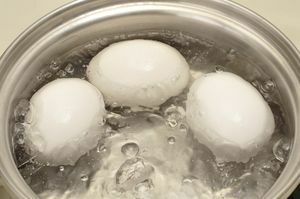
- To paint evenly, you need to wash the eggs with a soap solution or rub it with alcohol. Then they are poured cold cold water and put on a slow fire.
Cook should be at least half an hour, so that the protein darkens. Long cooking is caused by the subsequent storage of the product, otherwise it can simply not live to the parent's day. The water in this case requires a lot, in addition, you need to watch that it does not boil, and constantly pour.
Before staining the eggs can be wiped with vinegar, then the dye is absorbed better. Hands during the procedure should be dry and clean.
- Once the eggs are welded, they need to be put on a large dish. Wipe them with a towel is not worth it, they must dry themselves. The fact that the dyes of natural origin are less resistant than artificial, so wiping the shell, you can remove with the water and a good half of the paint.
- In order for the eggs to acquire a deep, saturated shade, they must be placed in the refrigerator right at the solution for the night.
- Prepared testicles are polished to a mirror shine using a cloth moistened with vegetable oil.
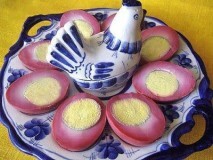
Eggs can be painted not only from the outside, but also from the inside. To do this, they need to boil for 3 minutes, then get and carefully pierce the shell from several places with a thin sharp needle. After that, boil until cooked.
Selection of natural dye
Popular onion peel stains the shell in a rich red-brown, orange or yellow color, it all depends on its amount and time, during which the eggs will be in solution.
What else can you paint eggs at home:
- Coffee and black tea give them a beautiful brown or natural beige color.
- Elderberry or blueberry berries will make Easter eggs tenderly lilac or blue.
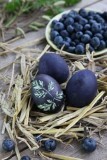 staining of blueberry eggs
staining of blueberry eggs 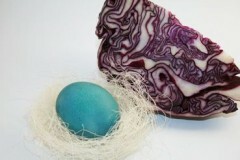 staining of eggs with red cabbage
staining of eggs with red cabbage 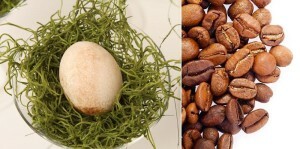 staining of eggs of coffee
staining of eggs of coffee
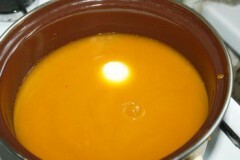 staining of eggs with carrot juice
staining of eggs with carrot juice 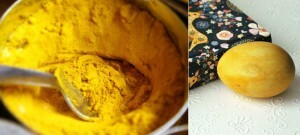 staining of eggs with turmeric
staining of eggs with turmeric 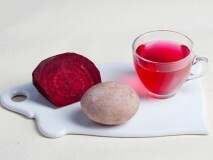 staining of eggs with beet juice
staining of eggs with beet juice
- Red cabbage will act as a blue natural dye.
- Carrots, oranges and lemons paint eggshells in a light yellow color.
- Beetroot gives the eggs a spectacular purple color.
- Turmeric - bright yellow. Spinach and nettle leaves are green.
- Cranberry, raspberry and cherry juice - pink and bright red.
- Beautiful muted yellow shade can be achieved with the help of walnut shells, chamomile flowers, saffron, St. John's wort.
So, if you have decided on natural dyes for Easter eggs, it's time to start the dyeing process.
Onion husks
This method was used by our grandmothers, but even now it is not 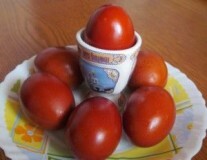 that has lost its relevance. In the process of staining the eggs acquire a beautiful saturated shade.
that has lost its relevance. In the process of staining the eggs acquire a beautiful saturated shade.
This will require a husk of at least 8 large bulbs, which is collected in advance.
Staining steps:
- Pour cold water into a large container, sprinkle the husk.
- Boil the broth and cook for 30 to 40 minutes. Allow the onion solution to infuse, drain. If the husks were prudently put in a nylon sock, the broth does not filter.
- Wait until the decoction has completely cooled down, pour in the prepared eggs.
- Cook for the required amount of time.
- Depending on what color is needed, eggs are either taken out of solution( then they turn out to be orange and bright yellow), or leave in solution for the night, so they will acquire an intense red-brown tint.
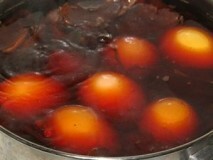
- To ensure that the eggs are subsequently cleaned well from the shell, they are poured with cold water, after which they can be put back into the solution.
- When the dye is completely absorbed, the eggs are wiped with vegetable oil, then they will acquire an effective mirror shine, you can do without it, then they turn out matte.
- A beautiful marble effect can be achieved if each egg is wrapped in onion husks and then boiled.
By the way, do not rush to pour the broth of onion husks after staining. You can use it for cooking purposes and bake a brisket in the husk. And women, striving to ensure that their hair always looked great, they know that you can rinse your hair with such a decoction. The husk not only strengthens them, but also gives a delightful rusty hue and shine to the hair.
How to color eggs in the broth of onion husk - video recipe
Beetroot
Available root can give the eggs a bright pink, and intense burgundy color. There are several options for staining with beets. Let's consider each of them in detail.
Option number 1:
- Grate 1 large beet, squeeze juice out of it.
- Put the boiled eggs in the solution.
- Pink color will be obtained if they are held for one hour, burgundy - if left overnight. It is important to ensure that the juice covers the eggs completely.

Option number 2:
- Beetroot to grate.
- Add the mixture with water.
- Add the vinegar to the solution.
- Put the juice on the fire and bring to a boil.
- In the solution put the boiled eggs. Their color will also depend on how long they will be in the beet water.
Option # 3:
- Grate the beetroot on a fine grater.
- The resulting gruel should be rubbed with eggs. Keep in mind that they can color unevenly, and on the shell will appear small specks.
Option number 4:
- Clear beet, cut into pieces.
- Pour root and raw eggs with cold water.
- Boil the time.
By the way, if you mix beetroot juice with turmeric and paint in the resulting egg solution, they will turn out to be a beautiful green color.
Karkade
If you want to get something original and surprise your 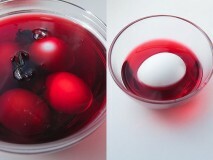 with beautiful Easter eggs of sky-blue color, then try painting them in exotic carcade( tea from the petals of the Sudanese rose).
with beautiful Easter eggs of sky-blue color, then try painting them in exotic carcade( tea from the petals of the Sudanese rose).
Staining steps:
- 500 ml karkade infused with boiling water in a large saucepan, cool.
- Boil eggs( they should be white).
- Dip the boiled eggs in the karkade solution, hold them there for a few minutes, take it out, dry it.
- Put it back in the broth. If the eggs are kept in the brew for a long time, they will acquire an unaesthetic gray shade.
Spinach
Green eggs of Easter eggs will color the most common spinach.
Staining steps: 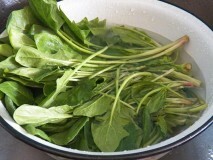
- Spinach Wash and dry.
- Each egg with a white shell is wrapped with a spinach leaf.
- Secure the leaves with threads, elastic bands or put eggs in a nylon sock.
- Boil the required amount of time.
- The solution is cooled and again put eggs in it to achieve the most bright, saturated color.
Important: if you use fresh spinach, the eggshell will be green, if frozen - beige, which also looks very impressive.
Turmeric
Staining in turmeric is very popular. White eggs acquire a pleasant light yellow hue, brown - rich orange.
Please note that turmeric is not completely soluble in water, so water carefully, so as not to hurt and damage the shell, you need to stir. It is advisable to take the pan from the old one, because the walls of the dishes will turn into a bright orange color and it will be difficult to wash it. This can be done with the help of the usual "Whiteness".
Turmeric is a highly coloring substance, so it is better to perform the procedure in gloves, and lay a table with oilcloth or newspapers.
Staining steps:
- Pour a package of turmeric( 20 grams) into a large container,
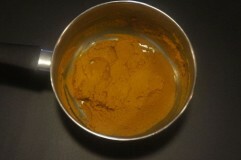 with water, put on strong fire and cook for 20 minutes.
with water, put on strong fire and cook for 20 minutes. - Dye the coolant. Add vinegar( 1 tablespoon to 7 liters of water) and salt( 1 tablespoon) into it.
- Prepared for the coloring of the eggs, add to the solution and cook, as usual.
- Boiled eggs to get out of the dyeing solution, to lower in cold water, to wash off the particles of turmeric. If you need a more saturated shade, they can be put in a cooled solution and left overnight.
Do not be scared if the protein also turns orange, it's just the action of a natural dye. There is no threat to health.
Red cabbage
Blue shade can be obtained, using not only the welding of 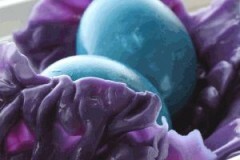 karkade tea, but red cabbage. There are two variants of staining:
karkade tea, but red cabbage. There are two variants of staining:
- The first, when boiled eggs are immersed in the juice of cabbage and left for several hours.
- The second - when they are brewed with cabbage juice.
In the first case, it turns out to be a celestial blue color, in the second - a saturated azure hue. Let's consider each option in detail.
Option # 1:
- Boil the eggs.
- Cut cabbage, grind with a blender until smooth.
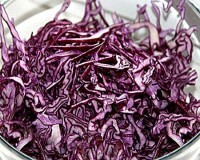 chopped cabbage
chopped cabbage 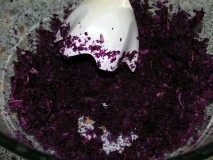 cabbage, crushed with blender
cabbage, crushed with blender
- Pour cabbage mixture with water and add vinegar. Infuse 1 hour.
- Squeeze out the mass from the cabbage cake.
- Pour the juice of boiled eggs and leave for 5 hours.
Option number 2
- Raw eggs pour cabbage juice.
- Cook as usual.
- Remove the eggs, then put them back into the cooled solution.
Decoction of birch leaves
Easter eggs are obtained delicious yellow-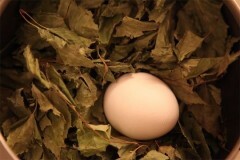 golden color, such an interesting shade can be achieved only with the help of natural coloring, not a single chemical dye is able to give such an effective shade. On the festive table, bright eggs will glow and play in the sun with golden shine.
golden color, such an interesting shade can be achieved only with the help of natural coloring, not a single chemical dye is able to give such an effective shade. On the festive table, bright eggs will glow and play in the sun with golden shine.
Staining steps:
- Remove birch leaves, put into a saucepan and pour cold water.
- Cook over low heat for half an hour.
- Decoction to insist for an hour.
- Prepared for coloring products pour chilled broth, cook until ready.
Blueberry tinting
With the help of frozen berries, you can color the eggs in deep blue. 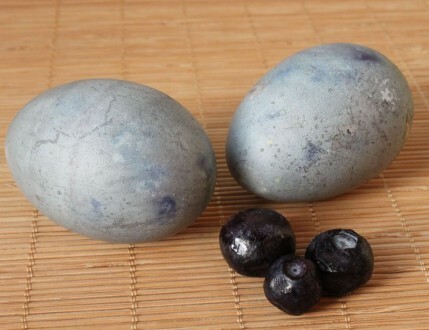
Staining steps:
- Beat the blueberries and, together with the liquid remaining after thawing, grind in a blender.
- Add a tablespoon of vinegar and half a glass of hot water into the berry mixture.
- Boiled eggs( the shell must be white) put in the mixture and leave for 5-6 hours.
The original ways of decorating with your own hands
You can connect all the households to the fascinating process, especially children like to do it.
- Colored eggs. Before coloring, roll them in rice( preferably long, it does not boil) and tightly wrap in gauze.
- Drawing "leaf".Before staining, attach to the egg a leaf of parsley or any herb-spice, fix
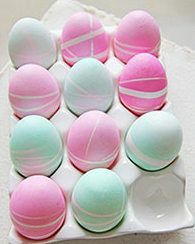 with its nylon stocking or gauze.
with its nylon stocking or gauze. - Smooth lines. Eggs can be tightened with usual pharmacy elastic bands in any order, painted in any way described above.
- Symbols, figurines and the inscription "ХВ".Before painting, glue on the eggs a strip of adhesive tape or paint tape. After staining the strips, carefully remove. Do this after the final drying of the dye.
- Cell. Wrap the eggs in net stockings or a net in which fruits and vegetables are sold, fixed with a thread.
- Lace. Cut out lacy napkins patterns or cut lace strips, fix on eggs with rubber bands. Dye in any dye. After staining and final drying of the dye, remove the gums and lace.

- The pattern of wax crayons. Before painting, paint the eggs with crayons. After painting, the pattern will appear.
- In silks.
Refined and unique drawings on Easter eggs are obtained by staining them with the help of fabrics, for example, pieces of an old silk tie or Pavlov-Pasadan scarves. You can use any other fabrics that you liked and want to reproduce.
- Raw eggs wrapped with a cloth - the face to the shell. The material will slip. To prevent this from happening, you must carefully sew it around the contour and wrap it with a cotton cloth or put it in a sock, fastening it to the blunt end.

- In a large saucepan pour the water, add 3 tablespoons of vinegar.
- Gently fold the eggs, cook for 10-15 minutes from the time of boiling.
- Prepare the testicles with cold water, after complete cooling, remove the tissue.
- A thin, effective pattern, the same as on the material used, will appear on the shell.
- Patterns of powdered sugar.
Beautiful dazzling white patterns with your own hands can be applied to painted eggs with the use of powdered sugar. The unusual printed invoice of the used ingredient 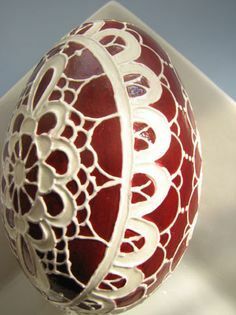 will make the Easter eggs unique, no matter what color they are painted, even in a delicate pastel, even in bright, saturated.
will make the Easter eggs unique, no matter what color they are painted, even in a delicate pastel, even in bright, saturated.
- The ready-made powdered sugar is used, but if it is not at hand, the usual sugar( one glass is enough) must be grinded in a coffee grinder. Powder mix with water so that a thick, viscous and homogeneous mass is obtained. The liquid mixture will spread over the egg.
- The resulting solution should be filled with a pastry syringe and applied to dyed and pre-chilled eggs.
- To make it easier to paint eggs, they need to be put in a glass or on a special stand. Instead of a syringe, you can use brushes.
- Tryapanka.
This painting technique has been used since ancient times. On dyed and chilled eggs with a knife or other sharp object, a layer of paint is scraped, so the desired pattern is created. Painting eggs for Easter is a great way to show creativity and imagination. Do not be afraid of experiments!
Related Videos:
 3:55
3:55 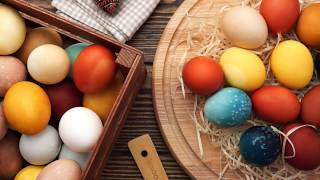 5:31
5:31 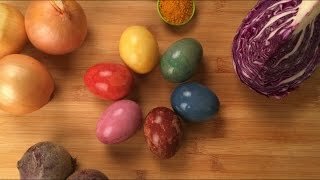 2:21
2:21 